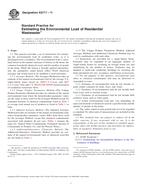Potřebujeme váš souhlas k využití jednotlivých dat, aby se vám mimo jiné mohly ukazovat informace týkající se vašich zájmů. Souhlas udělíte kliknutím na tlačítko „OK“.
ASTM E2717-11
Standard Practice for Estimating the Environmental Load of Residential Wastewater
Automaticky přeložený název:
Standardní praktiky pro odhad zátěže životního prostředí bytových odpadních vod
NORMA vydána dne 1.1.2011
Informace o normě:
Označení normy: ASTM E2717-11
Poznámka: NEPLATNÁ
Datum vydání normy: 1.1.2011
Kód zboží: NS-45917
Počet stran: 12
Přibližná hmotnost: 36 g (0.08 liber)
Země: Americká technická norma
Kategorie: Technické normy ASTM
Kategorie - podobné normy:
Anotace textu normy ASTM E2717-11 :
Keywords:
environmental load, sustainability, waste management, wastewater, wastewater treatment, water management, water stewardship, ICS Number Code 13.060.30 (Sewage water)
Doplňující informace
| Significance and Use | ||||||||
|
There is increasing concern regarding water quality. The first national-scale U.S. examination of these organic wastewater contaminants in streams, conducted by the Toxic Substances Hydrology Program of the U.S. Geological Survey (USGS), indicated that a broad range of chemicals found in residential, industrial, and agricultural wastewaters commonly occurs in mixtures at low concentrations downstream from areas of intense urbanization and animal production. The chemicals include pharmaceuticals, natural and synthetic hormones, detergent metabolites, plasticizers, insecticides, and fire retardants. One or more of these chemicals were found in 80 % of the streams sampled. This practice may be used by building owners and design professionals to assess water stewardship impacts of a residence. In particular, it is intended to inform design decisions and operation decisions regarding estimated wastewater quality impacts of a building. This practice may be used by planners and water treatment professionals to assess water stewardship impacts of a residential area. In particular, it is intended to inform infrastructure decisions regarding estimated wastewater quality impacts of a residential service area. This practice may be used to estimate the types and amounts of non-biological wastes entering a wastewater system. Such knowledge is becoming increasingly important in developing sustainable approaches to water stewardship. Table 2, Environmental Load for Average U.S. Single-Family Home, does not list all chemicals used in homes; in order to obtain a more accurate estimation, the chemicals used in specific homes should be listed. In addition, it may be helpful to monitor wastewater to determine variances, if any, from the estimated environmental load. |
||||||||
| 1. Scope | ||||||||
|
1.1 This practice provides a set of instructions for estimating the environmental load of residential water, as it is discharged from a residence. The environmental load is calculated based on the number and type of fixtures in the home, the common household chemicals used, and the number of people in the home. While the format is broadly applied internationally, the parameters stated herein reflect North American averages and would need to be modified if used elsewhere. 1.1.1 Averages Method—The Averages Method provides an estimate of the annual environmental load for the average U.S. single-family home based on 2000 U.S. Census and 2007 U.S. Census Data and U.S. EPA/625/R-00/008 characterization of residential wastewater flows. 1.1.2 Unique Product Parameters Method—The Unique Product Parameters Method provides an estimate of the annual environmental load, where the home/product parameter values are the same as those used for the Averages Method except for estimated amounts of chemical contaminants listed in Table 1 or average total annual use of products as listed in Table 1, or both. 1.1.3 Adjusted Averages Method—The Adjusted Averages Method provides an estimate of the annual environmental load, where home/product parameter values differ from those used for the Averages Method, except that chemical contaminants associated with products do not vary. (Table 1 remains the same for: Typical Water Contaminants, Estimated Amount of Contaminant in Product (%), and the Percent Waste.) 1.1.4 Additional/Alternative Chemicals Method—The Additional/Alternative Chemicals Method provides an estimate of the annual environmental load, of chemicals used that are not listed in Table 1. 1.1.5 The Unique Product Parameters Method, Adjusted Averages Method, and Additional Chemicals Method may be used in combination with each other. 1.2 Instructions are provided for a single-family home. Estimates may be expanded to an aggregate number of single-family homes by assuming an average home size and multiplying by the number of homes. Estimates may be adapted to multi-unit residential buildings by factoring the home parameters for size, occupancy, and fixtures as necessary. 1.3 For the purpose of this practice, environmental load refers to chemical contaminants that may be dissolved or suspended in water. 1.3.1 Estimates of environmental load do not include organic matter common for urine, feces, and vomit. 1.3.2 Estimates of environmental load do not include bulk food waste such as kitchen scraps. 1.3.3 Estimates of environmental load do not include bulk cellulose waste such as toilet paper. 1.3.4 Actual environmental load may vary depending on types and amounts of chemicals used in a specific home and the number of people in the home. |
||||||||
| 2. Referenced Documents | ||||||||
|



 Cookies
Cookies
